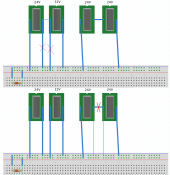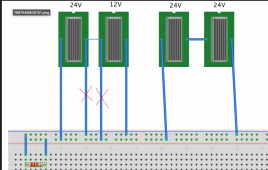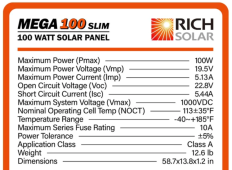vanlifeftw
New Member
Hi folks!
Thanks Will and company for making such an awesome community! I wanted to give my questions some context and talk about my project in general. I'm self-building a Ford Transit high roof (non-extended) camper. I have 16 x 304Ah factory direct Eve cells which I intend to assemble into 2 x 24V batteries. (I probably have another post coming about BMS selection). My idea was to have "full solar" on the roof covering my fans. I ended up buying 4 x 24V 200W Rich Solar panels. I decided to go with a strategy I learned about on the fordtransitusa forum, where the fan covers are removed and the solar panels become the thing that keeps rain out. Later I realized that the rear roof support constrained my fan placment very specifically to the point that I can really only fit 3 of the 4 Rich 200W panels mounted. DANG IT. I see maybe 2 ways to recover from this and pack as much solar on the roof as possible.
1) find a > 200W panel that's very close to 58.7 in by ~ 40 in. This has not been a fruitful search. Very open to suggestions!
2) try to incorporate one of Rich Solar's slim 12V 100W panels to give me a little more power. I contacted support about mixing these. They were not encouraging, but I think the way I asked the question prevented me form getting a yes. Also I'm sure it's in their best interest to practice CYA.
SO on to the question. Can I wire my panels like this? Please forgive the Fritizing diagram. The power rails of the breadboard represent a combiner inside the van. The resistor represents system load. I don't think I can put a 12V and 24V in series because the Max Power Current spec of both panels exceeds the Maximum Series Fuse Rating spec of the 100W slim. Also attaching the specs of both panels. I planning on using Victron Energy BlueSolar MPPT 150|35. Thanks for your time!!
Thanks Will and company for making such an awesome community! I wanted to give my questions some context and talk about my project in general. I'm self-building a Ford Transit high roof (non-extended) camper. I have 16 x 304Ah factory direct Eve cells which I intend to assemble into 2 x 24V batteries. (I probably have another post coming about BMS selection). My idea was to have "full solar" on the roof covering my fans. I ended up buying 4 x 24V 200W Rich Solar panels. I decided to go with a strategy I learned about on the fordtransitusa forum, where the fan covers are removed and the solar panels become the thing that keeps rain out. Later I realized that the rear roof support constrained my fan placment very specifically to the point that I can really only fit 3 of the 4 Rich 200W panels mounted. DANG IT. I see maybe 2 ways to recover from this and pack as much solar on the roof as possible.
1) find a > 200W panel that's very close to 58.7 in by ~ 40 in. This has not been a fruitful search. Very open to suggestions!
2) try to incorporate one of Rich Solar's slim 12V 100W panels to give me a little more power. I contacted support about mixing these. They were not encouraging, but I think the way I asked the question prevented me form getting a yes. Also I'm sure it's in their best interest to practice CYA.
SO on to the question. Can I wire my panels like this? Please forgive the Fritizing diagram. The power rails of the breadboard represent a combiner inside the van. The resistor represents system load. I don't think I can put a 12V and 24V in series because the Max Power Current spec of both panels exceeds the Maximum Series Fuse Rating spec of the 100W slim. Also attaching the specs of both panels. I planning on using Victron Energy BlueSolar MPPT 150|35. Thanks for your time!!









